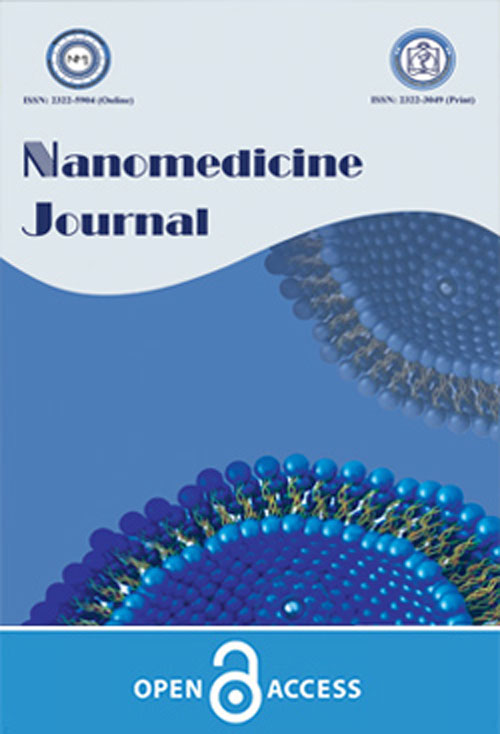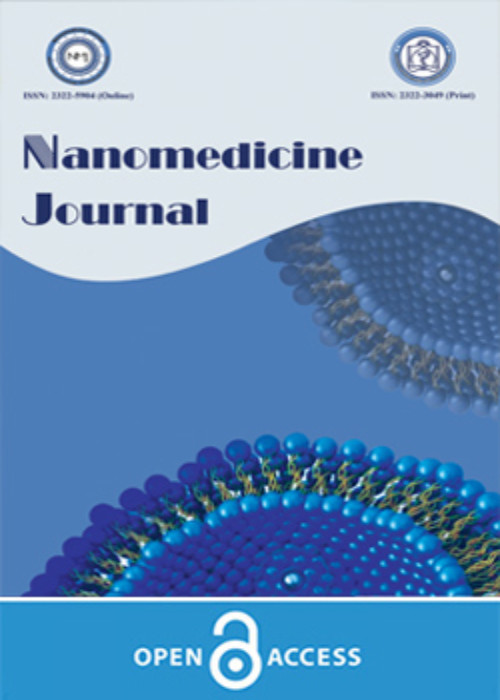فهرست مطالب

Nanomedicine Journal
Volume:2 Issue: 4, Autumn 2015
- تاریخ انتشار: 1394/06/23
- تعداد عناوین: 8
-
-
Pages 231-248This review focuses on the latest developments in applications of carbon nanotubes (CNTs) in medicine. A brief history of CNTs and a general introduction to the field are presented. Then, surface modification of CNTs that makes them ideal for use in medical applications is highlighted. Examples of common applications, including cell penetration, drug delivery, gene delivery and imaging, are given. At the same time, there are concerns about their possible adverse effects on human health, since there is evidence that exposure to CNTs induces toxic effects in experimental models. However, CNTs are not a single substance but a growing family of different materials possibly eliciting different biological responses. As a consequence, the hazards associated with the exposure of humans to the different forms of CNTs may be different. Understanding the structure–toxicity relationships would help towards the assessment of the risk related to these materials. Finally, toxicity of CNTs, are discussed. This review article overviews the most recent applications of CNTs in Nanomedicine, covering the period from 1991 to early 2015.Keywords: Carbon nanotubes, Drug delivery, Functionalization, Nanomedicine, Surface modification
-
Pages 249-260Objective(s)ISCOMATRIX vaccines have now been shown to induce strong antigen-specific cellular or humoral immune responses to a broad range of antigens of viral, bacterial, parasite or tumor. In the present study, we investigated the role of ISCOMATRIX charge in induction of a Th1 type of immune response and protection against Leishmania major infection in BALB/c mice.Materials And MethodsPositively and negatively charged ISCOMATRIX were prepared. BALB/C mice were immunized subcutaneously, three times with 2-week intervals, with different ISCOMATRIX formulations. Soluble Leishmania antigens (SLA) were mixed with ISCOMATRIX right before injection. The extent of protection and type of immune response were studied in different groups of mice.ResultsThe group of mice immunized with negatively charged ISCOMATRIX showed smaller footpad swelling upon challenge with L. major and the highest IgG2a production compared with positively charged one. The mice immunized with positively charged ISCOMATRIX showed the lowest splenic parasite burden compared to the other groups. Cytokine assay results indicated that the highest level of IFN- γ and IL-4 secretion was observed in the splenocytes of mice immunized with negatively charged ISCOMATRIX as compared to other groups.ConclusionThe results indicated that ISCOMATRIX formulations generate an immune response with mixed Th1/Th2 response that was not protective against challenge against L. major.Keywords: ISCOMATRIX, Immune response, Leishmania major, Surface Charge
-
Pages 261-268Objective(s)Medicinal benefits of quantum dots have been proved in recent years but there is little known about their toxicity especially in vivo toxicity. In order to use quantum dots in medical applications, studies ontheir in vivo toxicity is important.Materials And MethodsCdSe:ZnS quantum dots were injected in 10, 20, and 40 mg/kg doses to male mice10 days later, mice were sacrificed and five micron slides were prepared structural and optical properties of quantum dots were evaluated using XRD.ResultsHistological studies of testis tissue showed high toxic effect of CdSe:ZnS in 40 mg/kg group. Histological studies of epididymis did not show any effect of quantum dots in terms of morphology and tube structure. Mean concentration of LH and testosterone and testis weight showed considerable changes in mice injected with 40 mg/kg dose of CdSe:ZnS compared to control group. However, FSH and body weight did not show any difference with control group.ConclusionAlthough it has been reported that CdSe is highly protected from the environment by its shell, but this study showed high toxicity for CdSe:ZnS when it is used in vivo which could be suggested that shell could contribute to increased toxicity of quantum dots. Considering lack of any previous study on this subject, our study could potentially be used as an basis for further extensive studies investigating the effects of quantum dots toxicity on development of male sexual system.Keywords: CdSe:ZnS, In vivo toxicity, Quantum dots, ZnS shell
-
Pages 269-272Objective(s)In our study, graphene oxide-TiO2 nanocomposite (GO/TiO2) was prepared and used for the enrichment of rutin from real samples for the first time.Materials And MethodsThe synthesized GO/TiO2 was characterized by X-ray diffraction, scanning electron microscopy, and FT-IR spectra. The enrichment process is fast and highly efficient. The factors including contact time, pH, and amount of GO/TiO2 affecting the adsorption process were studied.ResultsThe maximum adsorption capacity for ciprofloxacin was calculated to be 59.5 mg/g according to the Langmuir adsorption isotherm. The method yielded a linear calibration curve in the concentration ranges from 15 to 200 μg/L for the rutin with regression coefficients (r2) of 0.9990. The limits of detection (LODs, S/N=3) and limits of quantification (LOQs, S/N=10) were found to be 8 μg/Land 28 μg/L, respectively. Both the intra-day and inter-day precisions (RSDs) were < 10%.ConclusionThe developed approach offered wide linear range, and good reproducibility. Owing to the diverse structures and unique characteristic, GO/TiO2 possesses great potential in the enrichment and analysis of trace rutin in real aqueous samples.Keywords: Enrichment, GO, TiO2, Nanocomposite, Rutin
-
Pages 273-282Objective(s)Zinc oxide nanoparticles (ZNP) are increasingly used in sunscreens, biosensors, food additives and pigments. In this study the effects of ZNP on liver of rats was investigated.Materials And MethodsExperimental groups received 5, 50 and 300 mg/kg ZNP respectively for 14 days. Control group received only distilled water. ALT, AST and ALP were considered as biomarkers to indicate hepatotoxicity. Lipid peroxidation (MDA), SOD and GPx were detected for assessment of oxidative stress in liver tissue. Histological studies and TUNEL assay were also done.ResultsPlasma concentration of zinc (Zn) was significantly increased in 5 mg/kg ZNP-treated rats. Liver concentration of Zn was significantly increased in the 300 mg/kg ZNP-treated animals. Weight of liver was markedly increased in both 5 and 300 mg/kg doses of ZNP. ZNP at the doses of 5 mg/kg induced a significant increase in oxidative stress through the increase in MDA content and a significant decrease in SOD and GPx enzymes activity in the liver tissue. Administration of ZNP at 5 mg/kg induced a significant elevation in plasma AST, ALT and ALP. Histological studies showed that treatment with 5 mg/kg of ZNP caused hepatocytes swelling, which was accompanied by congestion of RBC and accumulation of inflammatory cells. Apoptotic index was also significantly increased in this group. ZNP at the dose of 300 mg/kg had poor hepatotoxicity effect.ConclusionIt is concluded that lower doses of ZNP has more hepatotoxic effects on rats, and recommended to use it with caution if there is a hepatological problem.Keywords: Apoptosis, Nanomaterials, Oxidative stress
-
Pages 283-290Objective(s)The aim of this study was to prepare a nanosuspension formulation as a new vehicle for the improvement of the ocular delivery of vitamin A.Material And MethodsFormulations were designed based on full factorial design. A high pressure homogenization technique was used to produce nanosuspensions. Fifteen formulations were prepared by the use of different combinations of surfactants Tween 80, benzalkonium chloride and Pluronic and evaluated for pH, particle size, entrapment efficiency, differential scanning calorimetry (DSC), stability and drug release. Also, Draize test was used to evaluate the irritation of rabbit eye by formulations.ResultsAll formulations showed a small mean size that is well suited for ocular application. Also it was observed that the particle size decreased with increase in the amount of surfactant. Drug entrapment increased with increasing amount of surfactant. It was shown that initial and final drug release can be controlled by the ratio and the total amount of surfactants, respectively.ConclusionIt was concluded that the use of Tween 80 and Pluronic in the formualtions with a proper ratio does not show eye irritation and could be useful to achieve a suitable nanosuspension of vitamin A as a novel ocular delivery system.Keywords: Benzalkonium, Nanosuspension, Pluronic, Tween, Vitamin A
-
Pages 291-298ObjectivesBiofilms are communities of bacteria attached to surfaces through an external polymeric substances matrix. In the meantime, Acinetobacterbaumanniiis the predominant species related to nosocomial infections. In the present study, the effect of silver nanoparticles alone and in combination with biocides and imipenem against planktonic and biofilms of A. baumannii was assessed.Materials And MethodsMinimum inhibitory concentrations (MICs) of 75 planktonic isolates of A. baumannii were determined by using the microdilution method as described via clinical and laboratory standards institute (CLSI). Among all strains, 10 isolates which formed strong biofilms were selected and exposed to silver nanoparticles alone and in combination with imipenem, bismuth ethandithiol (BisEDT) and bismuth propanedithiol (BisPDT) to determine minimum biofilm inhibitory concentrations (MBIC). Subsequently, minimum biofilm eradication concentrations (MBECs) of silver nanoparticles alone and in combination with imipenem against mature biofilm of the isolates were evaluated.ResultsResults showed that 29.3% of isolates were susceptible to silver nanoparticles and could inhibit the growth and eradicate biofilms produced by the isolates. For this reason, ∑FIC, ∑FBIC and ∑FBEC ≤ 0.05 were reported which shows synergism between silver nanoparticles and imipenem against not only planktonic cells but also inhibition and eradication of biofilms. The results of ∑FBIC >2 indicated to antagonistic impacts between silver nanoparticles and BisEDT/BisPDT against biofilms.ConclusionIt can be concluded that silver nanoparticles alone can inhibit biofilm formation but in combination with imipenem are more effective against A. baumannii in planktonic and biofilm forms.Keywords: Acinetobacter baumannii, Biofilm, Bismuth ethandithiol (BisEDT), Bismuth propanedithiol (BisPDT), Imipenem, Silver nanoparticles (AgNPs)
-
Pages 299-304ObjectiveAt the present study, relationship between phagocytosis of PLGA particles and combined effects of particle size and surface PEGylation was investigated.Materials And MethodsMicrospheres and nanospheres (3500 nm and 700 nm) were prepared from three types of PLGA polymers (non-PEGylated and PEGylation percents of 9% and 15%). These particles were prepared by solvent evaporation method. All particles were labeled with FITC-Albumin. Interaction of particles with J744.A.1 mouse macrophage cells, was evaluated in the absence or presence of 7% of the serum by flowcytometry method.ResultsThe study revealed more phagocytosis of nanospheres. In the presence of the serum, PEGylated particles were phagocytosed less than non-PEGylated particles. For nanospheres, this difference was significant (P<0/05) and their uptake was affected by PEGylation degree. In the case of microsphere formulation, PEGylation did not affect the cell uptake. In the serum-free medium, the bigger particles had more cell uptake rate than smaller ones but the cell uptake rate was not influenced by PEGylation.ConclusionThe results indicated that in nanosized particles both size and PEgylation degree could affect the phagocytosis, but in micron sized particles just size, and not the PEGylation degree, could affect this.Keywords: PLGA particles, PEGylation, Phagocytosis, Size


